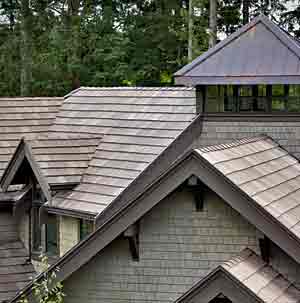Concrete Tiles: Durable, Sustainable Roofing Materials Integrate Design and Performance
Durability of Standard-Weight Tile
Concrete tile is a noncombustible roofing material; it's proven to be fire resistant. Additionally, the Universal Building Code requires that concrete tiles be able to withstand 50 cycles of freeze thaw and still maintain break strength (the amount of weight it can withstand upon initial testing). Concrete tile passes the freeze and thaws tests for clay, brick and structural material, as conducted by the American Society for Testing Materials (ASTM). This is an important quality not just in cold climates, where the tiles must withstand temperatures well below freezing for weeks on end, but also in regions or climates with wide swings between daily low and high temperatures.
Concrete tiles are also wind resistant. The material is wind tunnel tested by the ASTM to withstand winds of up to 125 miles per hour, an important feature for regions subject to tornadoes and hurricanes. Fastening options for concrete tile, such as nails, wind clips, screws, and adhesive foam, are tested to resist winds up to 140 miles per hour.
Concrete tile is also hail resistant. In 2005, the State of Texas Department of Insurance approved a new testing method for concrete roof tile developed in accordance with the Roof Tile Institute. In Texas and the greater Midwestern United States subject to annual hail season, the new Factory Manual 4473 will allow for reduced insurance rates for buildings with concrete tile.
|
In earthquakes, a study commissioned by the Tile Roof Institute suggests concrete and clay roof tiles withstand seismic forces far greater than the figure of 0.8 gravity acceleration the Uniform Building Code requires for other building components.
Beyond meeting the demands of certain extreme weather and climate conditions, concrete roof tiles must also meet several code requirements. According to the Uniform Building Code, the tiles must have enough transverse break strength, for example, to be able to withstand a load of at least 300 pounds placed on the center of the tile. In many areas of the country, concrete tile's durability will not only help protect the building physically, but can also contribute to lower insurance rates.
Moisture passing through the tile body must also be monitored on a regular basis. Code requires that the density of the concrete must be such that water cannot pass through the tile during a 24-hour test. Water absorption for standard weight tile should average between eight and 12 percent.
Concrete possesses ideal thermal and radiant properties, making it an attractive sustainable building choice. According to a 2000 study by the Florida Solar Energy Center, a concrete tile roof reduced the transfer of solar heat, or ceiling flux, by 48 percent compared to a black shingle roof. Much like a basement, it experiences more narrow temperature fluctuations.
Sustainability and durability are additional advantages of concrete tile. Since concrete tiles can last as long as 100 years, the material indirectly reduces construction waste because it has to be replaced less often than other roofing materials. Construction waste accounts for a sizable portion of total landfill space. Concrete tile also is not made with petroleum-based products, as asphalt shingles are, and therefore its cost may not be as vulnerable to oil price fluctuations.










